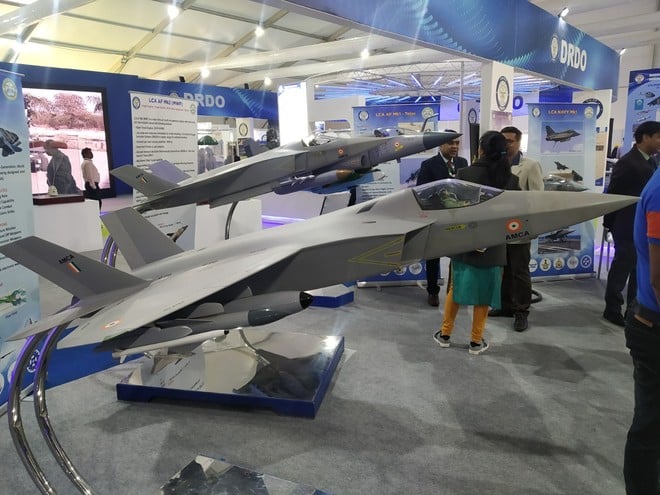Aviation
Manufacturing of the first prototype of India’s stealth fighter programme has begun

India is getting closer to achieving its goal of manufacturing its own fifth-generation combat jet as part of its persistent pursuit for self-reliance. The much-touted AMCA stealth fighter jet programmed, which has so far only existed on paper, is set to begin manufacturing.
India’s Defense Research and Development Organization recently announced the ‘metal cutting’ of the first prototype on Twitter.
The manufacture of the Leading Edge of AMCA began at HAL with specific material for the 5th generation design, based on the design of ADA and DRDO. Before being installed on the first prototype, the unit will be subjected to structural and other tests. AMCA has reached a significant milestone.
The AMCA will take to the skies for the first time in 2024-25, with series manufacturing commencing in 2028. Commercial defense businesses may be engaged in the manufacture of the combat jet, while HAL and ADA will handle the design and research. The upgraded stealth fighter will be a multi-role aircraft capable of air superiority, ground attack, enemy air defense suppression, and electronic warfare missions.
It will be a 25-tonne aircraft with a 1,500 kg internal payload and a 5,500 kg external payload, as well as 6,500 kg of internal fuel.
According to reports, the Indian Air Force has placed an order for 40 AMCA Mk-1 fighters and at least 100 Mk-2 versions.
Only the United States, Russia, and China have built their own fifth generation fighter jets thus far.
The AMCA will be developed in two stages: an AMCA MK1 with an existing GE414 afterburning turbofan engine that powers the LCA Tejas, and an AMCA MK2 with a new, more powerful engine.
With the AMCA, India will become only the fourth country to fly an indigenously manufactured stealth fighter aircraft. Turkey, on the other hand, is developing its own fifth-generation plane, the TF-X, with a debut date virtually equal to the Indian AMCA. Then there are the fifth-generation fighter jets being built in South Korea (KF-21) and Europe (Tempest and FCAS).
India formalises acquisition of 56 Airbus C295 aircraft
In addition, India and France are close to agreeing to work together on the development of a 125kN engine for the AMCA. The improved AMCA engine is intended to be jointly developed by the DRDO and Safran, a French engine company.
First A319neo flight with 100% sustainable aviation fuel
Because Safran and HAL currently work together on the Shakti engine, which powers the indigenous Advanced Light Helicopter Dhruv and its variations, a potential agreement for the AMCA engine should go smoothly.
The Russia’s 5 Most Dangerous Fighter Planes ever built.

Aviation
Airbus Enhances A350 Cabin with 10-Abreast Seating

Airbus has announced a new partnership with Jiatai Aircraft Equipment, a Chinese aircraft seating manufacturer, to supply upgraded economy-class seats for the A350 widebody series.
This collaboration, unveiled at the 2024 Airshow China, focuses on developing a newly designed economy seat tailored for the A350‘s New Production Standard (NPS) cabin.
One of the key features of the NPS cabin is the ability to accommodate 17-inch wide economy seats, compared to the previous 16.5-inch wide seats that airlines were limited to in the A350’s earlier configurations.
British Airways Unveils Its Brand-New First Class Cabin for the Airbus A380
This change is made possible by the expanded space in the NPS cabin, which is 35 inches longer and 4 inches wider than the previous version. This extra space is achieved by slightly moving the cockpit wall forward and shifting the rear pressure bulkhead back by one frame.
The wider cabin allows airlines to add up to 30 extra economy seats without compromising comfort. For airlines opting for a 3-4-3 seating layout, the 17-inch wide seats are an excellent choice for a more comfortable passenger experience. However, some airlines, such as Iberia, may choose to retain a 9-abreast layout with wider seats for added comfort.
The NPS cabin also offers enhanced flexibility for airline operators. One major advantage is the ability to easily switch between a 9-abreast and 10-abreast seating configuration without requiring significant downtime for aircraft reconfiguration. Airlines can use the same seat rails, tracks, and IFE interfaces, making the transition smoother and quicker.
Etihad Airways Unveils 10 Exciting New Routes for 2025
In addition, the design of the floor attachments and air-conditioning systems has been optimized for 10-abreast seating, meaning airlines can upgrade their cabins without needing to make substantial modifications to the aircraft’s structure.
Though it’s still unclear when Jiatai’s economy-class seats will be officially added to the A350’s Buyer Furnished Equipment (BFE) catalogue, the collaboration marks a significant step toward enhancing the A350’s cabin offerings.
With this partnership, Airbus is providing more seating options for airlines, ensuring that they can meet diverse customer needs while improving overall operational efficiency.
-

 Aviation2 months ago
Aviation2 months agoMicrosoft Flight Simulator Raises $3 Million to Bring Back the An-225 Mriya
-

 Airlines2 months ago
Airlines2 months agoQatar Citizens Can Travel to the United States Without a Visa
-

 Aviation2 months ago
Aviation2 months agoQatar Airways bans these new Electronic Devices on plane
-

 Airlines2 months ago
Airlines2 months agoJapan Airlines Rolls Out Free Domestic Flights to International Passengers
-

 Defence2 months ago
Defence2 months agoWhich Country Has the Largest Fleet of Fighter Aircraft?
-

 Airport2 months ago
Airport2 months agoWestern Sydney Airport Welcomes Its First Plane After 6 Years of construction
-

 Airlines4 days ago
Airlines4 days agoDAMAC Air: Dubai’s New Luxury Airline Offers Free Flights for Registration
-

 Aviation2 months ago
Aviation2 months agoDid you know ? Once Boeing 747 carried 1088 passenger in 1991








